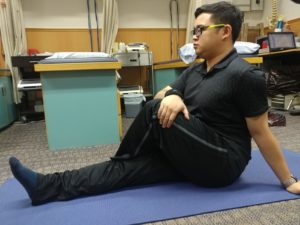Sciatica and Piriformis Muscle
This post is also available in: 中文
Sciatica? Who is the culprit?
Sciatica, a pain syndrome notorious for its disabling pain and symptoms, is not only always caused by irritation of sciatic nerve, but also the nerve’s origin (L4-S3 nerve roots). That’s why sciatica seems always related to low back pain and we may naturally attribute it to back problem e.g. prolapsed intervertebral disc (PID). At the buttock, there is a deep and small muscle, called PIRIFORMIS, underneath our strong gluteal muscles. Piriformis is mainly responsible for hip external rotation and abduction, e.g. during walking, especially when turning. Overuse may cause chronic tiredness and even inflammation at the muscle.

This muscle lies closely above the sciatic nerve, which may get irritated when the piriformis is swollen or inflamed. Related pain syndrome is therefore called Piriformis Syndrome.

Major signs and symptoms:
- Buttock pain, possibly radiating down to leg (mimicking sciatica symptoms)
- Pain affecting hip joint movements during various activities e.g. walking, squatting and stairs-walking
- Prolonged sitting, especially in low/hard chairs
Common causes:
- Muscle overuse, aggravated by predisposing sacroiliac joint instability or malalignment
- Injury caused by trauma
These can trigger inflammation, swelling and/or spasm at piriformis, and in turn may cause irritation to sciatic nerve, producing sciatica symptoms.
Sometimes, the low back spine and piriformis can simultaneously contribute to the pain. Solely treating the low back may not completely resolve the problem. Then we need to deal with the piriformis.
Physiotherapy treatments:
- According to individual situation, ultrasound therapy, acupuncture, deep friction massage are used for muscle relaxation/inflammation reduction to relieve symptoms
- Stretching exercise is vital to maintain the treatment effects (Diagram below)
- Strengthening the more superficial gluteal muscles is important to improve pelvic stability, which in turn reduce the loading to piriformis (Diagram below)
- Advice would be given according to daily activities and working habit, for example:
A. Avoid stools which are too low or hard, to alleviate pressure to the buttock
B. During office work, regular breaks (every ½ hour) should be taken to walk around

Piriformis Stretching Exercise

Bridging (Buttock strengthening) exercise
Case example:
Mr. Lam, aged 46, whose job requires prolonged sitting, complained of recent onset of LBP, with radiating pain and numbness down to ankle. MRI revealed the L5-S1 intervertebral disc protruded to right rear aspect, mildly compressing the right S1 nerve root. After 8 sessions of treatment, pain symptoms largely resolved, with residual right buttock dull ache and right thigh numbness occasionally. The progress was slow in recent sessions. Further examination revealed tender and taut spots over right piriformis muscle with usual thigh numbness reproduced upon compression. His condition was further improved after interferential therapy, ultrasound therapy and acupuncture specifically targeted to piriformis.


